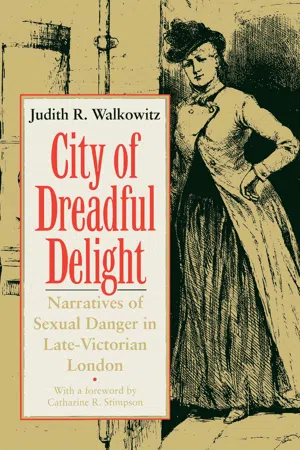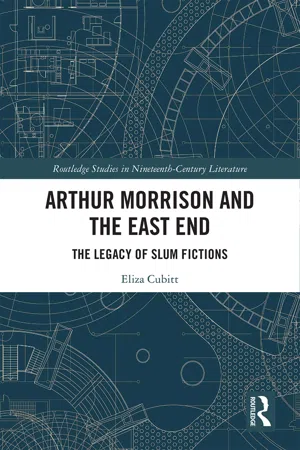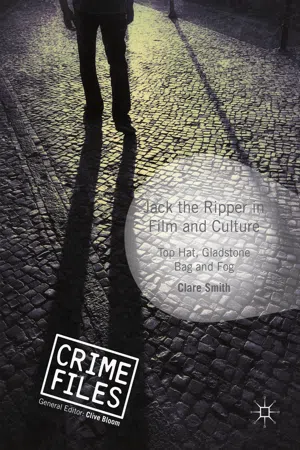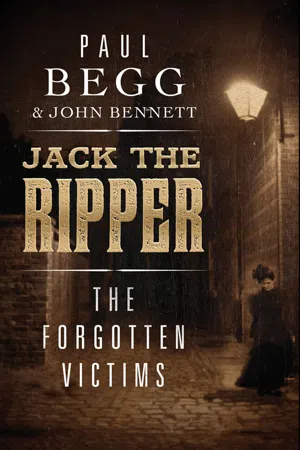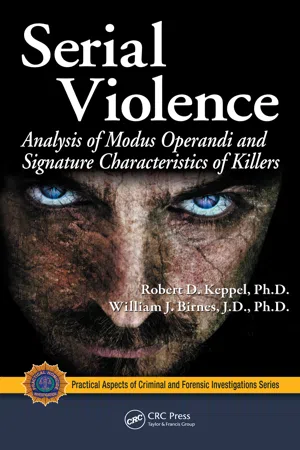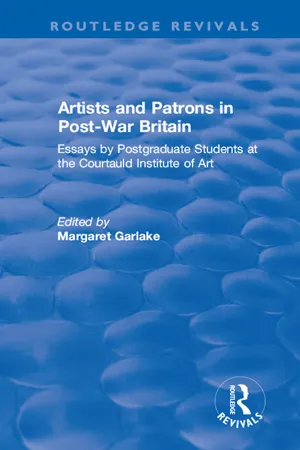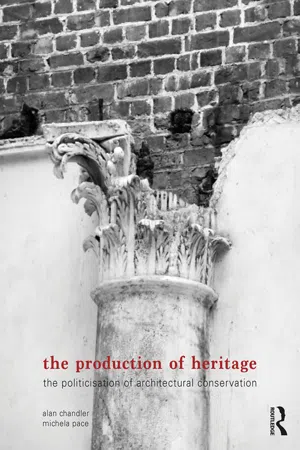History
19th Century Whitechapel
Whitechapel in the 19th century was a district in the East End of London known for its poverty, overcrowding, and high crime rates. It became infamous for the series of unsolved murders attributed to the unidentified serial killer known as Jack the Ripper. The area was also a hub for immigration, industrialization, and social reform movements during this period.
Written by Perlego with AI-assistance
Related key terms
1 of 5
7 Key excerpts on "19th Century Whitechapel"
- eBook - ePub
City of Dreadful Delight
Narratives of Sexual Danger in Late-Victorian London
- Judith R. Walkowitz(Author)
- 2013(Publication Date)
- University of Chicago Press(Publisher)
5For the respectable reading public, Whitechapel provided a stark and sensational backdrop for the Ripper murders: an immoral landscape of light and darkness, a nether region of illicit sex and crime, both exciting and dangerous. Like the deserted wasteland of Stevenson’s “city in a nightmare,” Whitechapel’s empty spaces could rapidly fill with a menacing crowd. “All sorts and conditions of men” could be met with on Whitechapel Road, the district’s main thoroughfare, with its “flaunting shops,” piles of fruit, and “streaming naphtha lamps.” A principal entertainment center for working-class London, Whitechapel Road also proved a magnet for rich young bloods from the West End who would tour the “toughest, roughest streets, taverns and music halls in search of new excitements.” This was Charles Booth’s “Tom Tiddler’s Ground”—imagined as a place of Darwinian drama and excitement—as compelling to the respectable observer as it was frightening.6At night, commentators warned, the glittering brilliance of Whitechapel Road contrasted sharply with the dark mean streets just off the main thoroughfare. Turning into a side street, one was “plunged” into the “Cimmerian” darkness of “lower London.” Here in the Flower and Dean Street area, with its twenty-seven courts, alleys, and lanes, stood one of the last remaining rookeries of late-Victorian London. “In these squalid parts of the metropolis,” reported the Daily Telegraph, “aggravated assaults, attended by flesh wounds from knives, are frequently met with, and men and women become accustomed to scenes of violence.” In streets with nicknames like “Blood Alley,” “Frying Pan Alley,” and “Shovel Alley” lay the “warrens of the poor,” “all packed by a species that multiples with astounding swiftness and with miserable results.” Here “it may be well to tuck out of view any bit of jewelry that may be glittering about.” Even the police hesitated to enter the notorious Wentworth and Dorset streets alone. In the Flower and Dean Street area it was useless for “them to follow when they happen to appear on the scene, as the houses communicate with one another, and a man pursued can run in and out.” In the same back slums and alleys, poor prostitutes, “fourpenny knee tremblers,” lived and worked, often bringing their customers into dark corners to avoid the price of a room. And here, in Buck’s Row, Hanbury Street, Berner Street, and Dorset Street (better known in the locale as “Do as You Please Street”), during the “autumn of terror” of 1888, the bodies of four of the victims of Jack the Ripper were found.7 - eBook - ePub
Arthur Morrison and the East End
The Legacy of Slum Fictions
- Eliza Cubitt(Author)
- 2019(Publication Date)
- Routledge(Publisher)
2 WhitechapelWriting the Victorian East End
By the late nineteenth century, the geographical understanding of the term ‘East End’ had become unsettled by the profusion of writings on the topic. Late-Victorian realists expected to be able to convey the ordinary experience of a shared material world. Yet when confronted with the slum space, ideas of the ‘shared’, ‘material’ and indeed ‘ordinary’ became troubled. Realist portraits of the East End became, by the 1890s, the search for reality in a space of fiction and fantasy. The Whitechapel murders of 1888, Bill Fishman argues, transformed the East End into ‘a national institution: a reservoir of constant fantasy’.1 However, Whitechapel, described by Morrison’s contemporary J.H. Mackay as ‘The East End in the East End’, was the subject of numerous recordings, both written and visual, for decades before the murders for which it is still remembered.2 In 1875, for example, Morrison’s role model Guy de Maupassant, favoured by Morrison for his restraint, wrote of Whitechapel as the site of a bizarre nocturnal adventure. Rather than becoming a notorious place because of the ‘Jack the Ripper’ murders, it seems Whitechapel was already notorious and the murders remained in the public consciousness because of the locality in which they took place.Despite the proliferation of writings purporting to ‘discover’ the East End, it frequently ‘relapsed again into the Unknown Land’.3 Morrison’s work to some extent prohibited such relapse. Morrison’s first writing on the East End was published in 1888, the year the Whitechapel murders began. In his early sketches, the series ‘Cockney Corners’ (1888–1889), he endeavours to write back the variegation of the area, countering a fantastic image of the East End. Each discrete area has manifold qualities. In a discussion of his early sketches, with a focus on ‘Whitechapel’ (1888), this chapter looks in depth at how Morrison complicates previous depictions of the East End, striving to attain a representation of a place that ‘stares beyond the interested visitor […] to things it supposes a stranger would not understand if he were told’.4 - eBook - ePub
Jack the Ripper in Film and Culture
Top Hat, Gladstone Bag and Fog
- Clare Smith(Author)
- 2016(Publication Date)
- Palgrave Macmillan(Publisher)
2However, if London as a whole was dark, Whitechapel was black, the colour allocated to five Whitechapel Streets by Charles Booth in his map of London poverty. Black meant that the streets were occupied by people who were ‘vicious, semi criminal’3 and cemented the reputation of the area for poverty and crime. This placed Whitechapel as ‘other’ or outcast and this image was cemented in the public consciousness by religious reformers such as, Charles Booth and Rev. Samuel Barnett who treated the East End as they would an African mission, Barnett going so far as to live among the ‘natives’.The idea of Whitechapel as outside London and a place of exotic exploration was encapsulated by the US writer Jack London, not just in his decision to disguise himself as a poor man in a combination of tourism and social anthropology. Jack London went to the travel agent Thomas Cook to ask them to organise his trip but they could not help, causing London to bemoan that they could send him to ‘innermost Tibet, but to the East End of London, barely a stone’s throw from Ludgate Circus, you know not the way!’4 The member of staff who serves London does agree to try to remember his face in case of murder so that ‘we would be in position to identify the corpse’.5 Not only was the East End exotic it was also dangerous.The Whitechapel murders cemented the reputation of Whitechapel as a place of danger and poverty. The press coverage of the murders emphasised the lives of the poor who would spend each day trying to acquire the few pence needed to share a bed in a rooming house. The only film that portrays the poverty of Whitechapel is From Hell . Other films engage with Whitechapel as dangerous and ‘other’ but often skirt over the reality of the poverty. The film aims for historical authenticity, in scene design if not plot, and shows the reality of the lives of the victims. One scene shows the women asleep on a bench held in place, as they sleep, by a rope. This was the cheapest and therefore the most uncomfortable way to spend a night apart from sleeping on the street. Films such as Love Lies Bleeding - No longer available |Learn more
Jack the Ripper
The Forgotten Victims
- Paul Begg, John Bennett(Authors)
- 2020(Publication Date)
- Yale University Press(Publisher)
It had attracted the attention and scrutiny of a veritable army of mostly well-to-do philanthropists, determined to rescue and even convert the fallen. They were duly accompanied by journalists, novelists, social investigators, artists and photographers intent on satisfying the curiosity of a sensation-seeking public. In the eyes of that public, unfamiliar with the general realities of a fractious locale, 35 the East End was a putrid, foul-smelling warren of slums, populated by bullies and petty thieves, wretched, bootless children and dirty, amoral women. It was a district that inspired revulsion and (at times) sympathy, yet with all its taboos, this ‘alien’ land was alluring and captivating. 36 And then, on top of everything, came the Whitechapel murders – that series of unsolved East End crimes which has become associated with the almost mythical figure of Jack the Ripper. It need scarcely be emphasized that these murders, in terms of their impact and ability to fascinate, are unparalleled in the history of crime. Over 120 years have passed since they were committed, during which time the enigmatic figure of Jack the Ripper has become the subject of innumerable books and television programmes. His development as a figure of London folklore, as the stalker in the fog, with his top hat, cloak and black bag, has seen him become the subject of musicals and operas, Hollywood horror movies, video games, novels, comic books and pop records. Every year millions of people visit Ripper-themed exhibits at the London Dungeon 37 or Madame Tussauds, and go on guided walks of the East End streets made famous by the grisly crimes. 38 It is truly a phenomenon. But why? There are a number of reasons, but timing must surely be high on the list. As we have just seen, the political and economic development of the East End of London meant the area was very much on people's minds at exactly the time that it became the killing ground of Jack the Ripper - eBook - PDF
Serial Violence
Analysis of Modus Operandi and Signature Characteristics of Killers
- Robert D. Keppel, William J. Birnes(Authors)
- 2008(Publication Date)
- CRC Press(Publisher)
Only one murder was recorded for the entire Whitechapel area in 1889 and again in 1890 (Paley, 1996). This suggests that although the Whitechapel area was crime laden, the occurrence of murder was rare. However, other analysts (Emmerichs, 2001) have shown that murders in Whitechapel were likely more common and typical of other high crime rate areas in London. There are a number of reasons for this. Recordkeeping was not systematic; the classification of cause of death was rudimentary, haphazard, and often inaccurate; the official residence of the victim had to be in Whitechapel to be counted; and the poverty of the residents and victims (referred to at the time as members of the “dangerous classes”) militated against any official legal action. Analyses of nineteenth century London coroners’ records indicate that it was unusual for a coroner to classify suspicious homicides as murders. Coroners were paid by a Justice of the Peace for their investigations, which were typically not requested because they were considered unnecessary. Coroners were not required to have a medical background until 1926, so they were often involved in occupations other than medicine. Emmerich’s (2001) examination of hundreds of inquests performed in the nineteenth century in London indi-cates that the criminal homicide rate was much higher than reported in the sparse and unreliable documents of the time. The eleven Whitechapel murders examined in this chapter occurred over a 10-month time span (Table 3.1). The primary questions are: Were the eleven murders the work of the individual referred to as Jack the Ripper ? Or, was it some subset of the total number of possible Ripper victims? If so, how many? The Jack the Ripper Murders 41 Which ones? How are they linked? Before those questions are answered, each of the cases will be described briefly. - eBook - ePub
- Courtauld Institute of Art, Margaret Garlake(Authors)
- 2017(Publication Date)
- Routledge(Publisher)
18 and for large-scale work.The site of the Gallery19 on Whitechapel High Street adjoining the Public Library underlines its social significance, since it was considered that both buildings provided ‘the means for the social advancement of the working classes, and gave them a respectable and sober form of recreation’.20 In the early 1950s, Whitechapel was a deprived working class area, containing a long-established Jewish community and an emerging immigrant population from the Commonwealth. In the 1960s a community of artists was attracted to the area by its supply of affordable studio space. Throughout the period however, the Whitechapel public was significantly different from that of other London art galleries. This difference could be advantageous for, as Robertson wrote to Barbara Hepworth, ‘The Gallery attracts an extremely large public. All the West End people come here, large numbers of East Londoners and people from the City who do not normally visit the galleries … the exhibition would be seen by the largest number of people.’21There were two distinct Whitechapel publics: one reflected the local population in all its diversity and the other embraced a West End audience, City business people and art world professionals. The Whitechapel could be said to function as ‘other’ for the West End and art professional public, some of whom regarded their visits to the East End as forays into a sub-culture which confirmed the superiority of their home ground and the values which lay behind the idea of an art establishment. The Whitechapel’s potential also to function as ‘other’ for the East End public and the danger that it might confer an outsider status on the local visitor by presenting an elitist programme, was a constant subject for debate by the Trustees. Serving the needs of the local public was fundamental to the Whitechapel ethos, and the Trustees’ minutes record many hours of discussion on this topic, particularly in the 1960s when what was perceived as neglect of those needs seemed to threaten the financial position of the Gallery. However, when he first joined the Gallery, Robertson observed resistance to what had generally been perceived as art with local appeal. The social realism of John Berger’s ‘Looking Forward’ (1952) was not well received by the local public, who found it colourless and despondent, despite the supposed accessibility of its realist subject matter.22 - eBook - ePub
The Production of Heritage
The Politicisation of Architectural Conservation
- Alan Chandler, Michela Pace(Authors)
- 2019(Publication Date)
- Routledge(Publisher)
The philanthropic mission of its founders, offering opportunities to local people to become artists as part of growing a culturally richer community, established a model of engagement that started to lose sharpness with time, shifting from social intent into artistic signature. While the building changed and expanded, its popular character also transformed towards a more elitist conception of art. The fact that this coincided with the involvement of international artists does not necessarily mean the loss of engagement intentions and of interest in the context. Rather, it was the shift towards import and branding that characterised the change in character of the gallery. The necessity for the gallery to grow on the international stage by importing rather than producing and exporting art is also linked to the liveability of the area and the changes that inform its social and built fabric. Originally an underprivileged area of London, Whitechapel cyclically hosted immigrant communities and workers over centuries. It is characterised by mixed cultures and blended traditions and, as in other marginal areas, it hosted artist communities because of the affordability of the rent. The processes of gentrification that started in the last century impact local and artists’ communities alike, fundamentally altering both existing buildings through hikes in the cost of inhabiting them, and with new buildings that cluster into ‘areas of regeneration’ providing unaffordable investment potential to ‘elsewhere’ investors. The change in the conception of the ‘artist’ as an ‘imported professional’ grew parallel to these urban ‘regenerations’ to the point where poverty and art practice were decoupled and ‘creative districts’ are now being created from scratch as part of wider regeneration programmes. However, none of the artists who settled in fringe areas in the past would be able to afford to live in a ‘creative district’ as such. That leaves us two options: either the artists who can settle there are a new kind of wealthier ‘creative’, or they are sponsored by someone. Surely art does not need to be poor to be valuable, and it is well known that many of the great works of art are born from patronage and commissions, but it is difficult to imagine the same freedom of action that produced, differentiated and radical creation within these ‘artistic’, pre-packaged enclaves with elite opportunities.Lessons learnedThe St. Pancras and Whitechapel case studies highlighted the necessity to reflect on the concepts of authenticity, craftsmanship, authorship and sense of place. The ways these concepts link one to another is not obvious and depend on our ability to read the transformation of the social and economic context in the layered history of buildings, which become – as Morris would put it – real documents of time.
Index pages curate the most relevant extracts from our library of academic textbooks. They’ve been created using an in-house natural language model (NLM), each adding context and meaning to key research topics.
